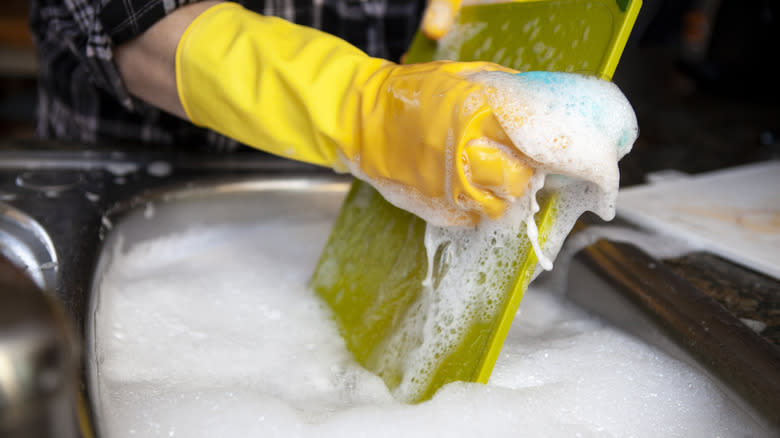The Best Way To Clean Plastic Cutting Boards And Remove Stains

Plastic cutting boards are great as an affordable option for this kitchen necessity, but they aren't without their drawbacks. All cutting boards need to be cleaned regularly, but plastic cutting boards in particular are known for the big cuts and gashes left behind; those can be breeding grounds for nasty bacteria. Luckily, cleaning your board regularly not only prevents that potentially dangerous buildup but also gets rid of any stains.
The simplest way to clean your plastic cutting board is to wash it in the dishwasher if it's safe to do so. But regularly washing a plastic cutting board in the dishwasher can cause it to warp. To increase the lifespan of your cutting board, it's better if you clean it by hand.
If the board has gotten really dirty, with a significant amount of stains and a questionable level of sanitation, use bleach. Mix one teaspoon with four cups of water. Now take a sponge and scrub the cutting board using your diluted bleach cleaning solution. The dilution might make it okay for you to use your bare hands but you should wear gloves to keep from getting bleach on your skin and avoid irritation. When you're done scrubbing, rinse it off with water and allow it to dry before using it again.
Read more: 11 Cleaning Tips For Keeping Your Oven Spotless
Cleaning Without Bleach

Not everybody likes using bleach, especially on surfaces that are going to touch our food. You're in luck because there are plenty of cleaning methods that don't rely on harsh chemicals. If you want to go for a natural cleaning agent, take some lemons and cut them open. Squeeze the juice over the board and allow it to soak. This is unlikely to remove any stains, which is why bleach is better, but lemon juice is a natural antibacterial agent so you'll at least be reducing your risk of cross-contamination.
Your second non-bleach option is to mix 4 tablespoons of baking soda, 1 tablespoon of dish soap, and 2 tablespoons of food-grade hydrogen peroxide. Once you've mixed them, slather your DIY cleaning agent onto the surface of your cutting board and allow it to sit overnight. In the morning, rinse it with soap and water. If you have the ingredients and the time to do it, you'll see more of an improvement with this over the lemon juice but bleach is still the best in terms of end results.
Read the original article on Tasting Table.

